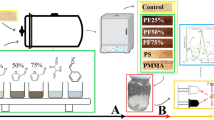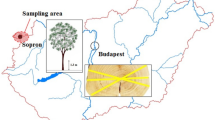Abstract
Thermochemical changes during wood-dowel welding were investigated in two Canadian hardwood species commonly used for indoor appearance applications: sugar maple (Acer saccharum) and yellow birch (Betula alleghaniensis). The original reference wood sample and the welded interface between two bonded wood pieces, a dowel and a substrate, were compared to explain differences in mechanical properties between species. Pyrolysis gas chromatography–mass spectrometry (Py-GC/MS), attenuated total reflection Fourier transform infrared spectroscopy (ATR-FTIR), and X-ray photoelectron spectroscopy (XPS) were used. The gases emitted during wood welding were determined by Py-GC/MS and gas chromatography coupled with a thermal conductivity detector and a flame ionization detector (GC-TCD/FID). Results showed that thermal welding of birch and maple woods degrades hemicelluloses and affects lignin polymer through depolymerisation. Welding effectiveness is therefore directly associated with the properties of the original wood constituents, primarily lignin and carbohydrates. The lignin-related changes at the welded interface were greater for sugar maple than for yellow birch, corroborating mechanical property differences observed between the two species. The gases proportions were similar for both species and no harmful gases were detected in the smoke released during welding process.
Zusammenfassung
Untersucht wurden die thermochemischen Veränderungen, die beim Einbringen von Dübeln mittels Reibschweißen in zwei in Kanada für Innenanwendungen häufig verwendeten Laubholzarten Zuckerahorn (Acer saccharum) und Gelbbirke (Betula alleghaniensis) auftreten. Die Schweißfläche zwischen den zwei verbundenen Holzteilen, einem Dübel und einem Holz, und dem nicht betroffenen Holz wurden verglichen, um unterschiedliche mechanische Eigenschaften beider Holzarten anhand von Pyrolyse-Gaschromatographie–Massenspektrometrie (Py-GC/MS), Fourier-Transformations-Infrarot-Spektroskopie in abgeschwächter Totalreflexion (ATR-FTIR) und Röntgen-Photoelektronenspektroskopie zu bestimmen. Die beim Reibschweißen emittierten Gase wurden bestimmt mittels Py-GC/MS und Gaschromatographie gekoppelt mit einem Wärmeleitfähigkeitsmesser und einem Flammenionisationsdetektor (GC-TCD/FID). Die Ergebnisse zeigten, dass beim Reibschweißen von Birken- und Ahornholz Hemicellulosen abgebaut werden und auch das Ligninpolymer depolimerisiert wird. Die Güte der Verschweißung hängt deswegen direkt von den Eigenschaften der zu verschweißenden Holzbestandteile ab, insbesondere dem Lignin und der Kohlenhydrate. Veränderungen des Lignins an der Schweißfläche waren bei Zuckerahorn größer als bei Gelbbirke und bestätigen damit die unterschiedlichen mechanischen Eigenschaften beider Holzarten. Die Gasanteile waren bei beiden Holzarten vergleichbar und im Rauch, der beim Schweißen entsteht, wurden keine schädlichen Gase festgestellt.


Similar content being viewed by others
References
Advanced Industrial Science and Technology (AIST) (2011) Spectral database for organic compounds. http://riodb01.ibase.aist.go.jp/sdbs/cgi-bin/direct_frame_top.cgi. Accessed 19 December 2011
American Society for Testing and Materials (2006) Standard test methods for evaluating properties of wood-base fiber and particle panel materials. ASTM D1037. PA
Anglès MN, Ferrando F, Farriol X, Salvadó J (1999) Binderless composites from pretreated residual softwood. J Appl Polym Sci 73:2485–2492
Anglès MN, Ferrando F, Farriol X, Salvadó J (2001) Suitability of steam exploded residual softwood for the production of binderless panels. Effect of the pre-treatment severity and lignin addition. Biomass Bioenerg 21:211–224
Anonymous (2010) Operating Instructions - Universal Sample Pump. Catalog No. 224-PCXR4. SKC. PA, USA
Belleville B, Stevanovic T, Pizzi A, Cloutier A, Blanchet P (2012) Determination of optimal wood welding parameters for two North American hardwood species. J Adhes Sci Technol (in press)
Canada Health (1989) Exposure guidelines for residential indoor air quality—a report of the federal-provincial advisory committee on environmental and occupational health. Ontario, Canada
Centre Canadien d’Hygiène et de Sécurité au Travail (CCHST) (2012) Effets du dioxyde de carbone sur la santé. http://www.cchst.ca/oshanswers/chemicals/chem_profiles/carbon_dioxide/health_cd.html. Accessed 16 January 2012
Colom X, Carrillo F, Nogués F, Garriga P (2003) Structural analysis of photodegraded wood by means of FTIR spectroscopy. Polym Degrad Stab 80:543–549
del Río JC, Gutiérrez A, Hernando M, Landín P, Romero J, Martínez AT (2005) Determining the influence of eucalypt lignin composition in paper pulp yield using Py-GC/MS. J Anal Appl Pyrol 74:110–115
Delmotte L, Ganne-Chedéville C, Leban J-M, Pizzi A, Pichelin F (2008) CP-MAS C13 NMR and FT-IR investigation of the degradation reactions of polymer constituents in wood welding. Polym Degrad Stab 93:406–412
Faix O, Meier D, Fortmann J (1990) Thermal degradation products of wood: gas chromatographic separation and mass spectrometric characterization of monomeric lignin derived products. Holz Roh Werkst 48:281–285
Faix O, Fortmann J, Bremer J, Meier D (1991) Thermal degradation products of wood: gas chromatographic separation and mass spectrometric characterization of polysaccharide derived products. Holz Roh Werkst 49:213–219
Fengel D, Wegener G (2003) Wood—chemistry, ultrastructure, reactions. Verlag Kessel, Munich
Geib SM, Filley TR, Hatcher PG, Hoover K, Carlson JE, Jimenez-Gasco M, Nakagawa-Izumi A, Sleighter RL, Tien M (2008) Lignin degradation in wood-feeding insects. Proc Natl Acad Sci USA 105(35):12932–12937
Gfeller B, Zanetti M, Properzi M, Pizzi A, Pichelin F, Lehmann M, Delmotte L (2003) Wood bonding by vibrational welding. J Adhes Sci Technol 17(11):1573–1589
Gilbert V (2005) Caractérisation des résidus provenant de l’industrie de la seconde transformation des panneaux de particules et de fibres. Dissertation, Université Laval
Hakkou M, Pétrissans M, Zoulalian A, Gérardin P (2005) Investigation of wood wettability changes during heat treatment on the basis of chemical analysis. Polym Degrad Stab 89:1–5
Hill CAS (2006) Wood modification: chemical, thermal and other processes, Chapter 5. Wiley, Chichester, pp 99–127
Inari GN, Pétrissans M, Lambert J, Ehrhardt JJ, Gérardin P (2006) XPS Characterization of wood chemical composition after heat treatment. Surf Interface Anal 38(10):1336–1342
Kotilainen RA, Toivanen TJ, Alén RJ (2000) FTIR monitoring of chemical changes in softwood during heating. J Wood Chem Technol 20(3):307–320
Kudo K, Yoshida E (1957) On the decomposition process of wood constituents in the course of carbonization, I. The decomposition of carbohydrate and lignin in mizunara (Quercus crispula Blume) wood. J Jap Wood Res Soc 3(4):125–127
Li J, Henriksson G, Gellerstedt G (2007) Lignin depolymerization/repolymerization and its critical role for delignification of aspen wood by steam explosion. Bioresour Technol 98(16):3061–3068
Mobarak F, Fahmy Y, Augustin H (1982) Binderless lignocellulose composite from bagasse and mechanism of self-bonding. Holzforschung 36:131–135
Mohan D, Pittman CU Jr, Steele PH (2006) Pyrolysis of wood/biomass for bio-oil: a critical review. Energy Fuel 20(3):848–889
National Institute Standards and Technology (2000) XPS Database. NIST Standard Reference Database 20, Version 3.3
Nonier MF, Vivas N, Vivas de Gaulejac N, Absalon C, Soulié PH, Fouquet E (2006) Pyrolysis–gas chromatography/mass spectrometry of Quercus sp. wood: application to structural elucidation of macromolecules and aromatic profiles of different species. J Anal App Pyrol 75:181–193
Nuopponen M, Wikberg H, Vuorinen T, Maunu SL, Jamsa S, Viitaniemi P (2004) Heat-treated softwood exposed to weathering. J Appl Polym Sci 91:2128–2134
Omrani P, Mason E, Pizzi A, Mansouri HR (2008) Emission of gases and degradation volatiles from polymeric wood constituents in friction welding of wood dowels. Polym Degrad Stab 93(4):794–799
Omrani P, Pizzi A, Mansouri HR, Leban J-M, Delmotte L (2009) Physico-chemical causes of the extent of water resistance of linearly welded wood joints. J Adhes Sci Technol 23(6):827–837
Pizzi A, Leban J-M, Kanazawa F, Properzi M, Pichelin F (2004) Wood dowel bonding by high-speed rotation welding. J Adhes Sci Technol 18:1263–1278
Rodriguez G, Diouf P, Blanchet P, Stevanovic T (2010) Wood dowel bonding by high-speed rotation welding—application to two Canadian hardwood species. J Adhes Sci Technol 24(8–10):1423–1436
Salmén NL (1982) Temperature and water induced softening behavior of wood fiber based materials. Dissertation, Swedish Forest Products Research Laboratory, Paper Technology Department, Stockholm, Sweden
Sanderman W, Augustin H (1964) Chemical investigations on the thermal decomposition of wood—part III: chemical investigation on the course of decomposition. Holz Roh Werkst 22:377–386
Sarni F, Moutounet M, Puech JL, Rabier P (1990) Effect of heat-treatment of oak wood extractable compounds. Holzforschung 44(6):461–466
Schäfer M, Roffael E (2000) On the formaldehyde release from wood. Holz Roh Werkst 58:259–264
Seah MP, Gilmore LS, Beamson G (1998) XPS: binding energy calibration of electron spectrometers 5—re-evaluation of the reference energies. Surf Interface Anal 26(9):642–649
Sreemany M, Ghosh TB (1994) On the XPS peak shape analysis. Appl Surf Sci 81(3):365–375
Stamm B, Windeisen E, Natterer J, Wegener G (2006) Chemical investigations on the thermal behaviour of wood during friction welding. Wood Sci Technol 40:615–627
Sudo K, Shimizu K, Sakurai K (1985) Characterization of steamed wood lignin from beech wood. Holzforschung 39:281–288
Sun Y, Royer M, Diouf P, Stevanovic T (2010) Chemical changes induced by high-speed rotation welding of wood—application to two Canadian hardwood species. J Adhes Sci Technol 24(8–10):1383–1400
Suzuki S, Shintani H, Park SY, Saito K, Laemsak N, Okuma M, Iiyama K (1998) Preparation of binderless boards from steam exploded pulps of oil palm (Elaeis guineensis Jaxq.) fronds and structural characteristics of lignin and wall polysaccharides in steam exploded pulps to be discussed for self-bindings. Holzforschung 52:417–426
Tanahashi M, Goto T, Horii F, Hirai A, Higuchi T (1989) Characterization of steam-exploded wood, III, transformation of cellulose crystals and changes of crystallinity. Mokuzai Gakkaishi 35:654–662
Tougaard S (1989) Practical algorithm for background subtraction. Surf Sci 216(3):343–360
Vallée V, Buelna G (2006) La valorisation des résidus de panneaux à base de bois Centre de recherche industrielle du Québec, Innovations technologiques—TE. http://www.icriq.com/fr/productique_tfp.html/-/asset_publisher/n2sB/content/la-valorisation-des-residus-de-panneaux-a-base-de-bois/maximized. Accessed 11 February 2012
van Dam JEG, van den Oever MJA, Teunissen W, Keijsers ERP, Peralta AG (2004) Process for production of high density/high performance binderless boards from whole coconut husk. Part 1: lignin as intrinsic thermosetting binder resin. Ind Crop Prod 19:207–216
van der Hage E, Mulder M, Boon J (1993) Structural characterization of lignin polymers by temperature-resolved in-source pyrolysis–mass spectrometry and Curie-point pyrolysis–gas chromatography/mass spectrometry. J Anal Appl Pyrol 25:149–183
Velásquez JA, Ferrando F, Salvadó J (2002) Binderless fiberboard from steam exploded Miscanthus sinensis: the effect of a grinding process. Holz Roh Werkst 60:297–302
Velásquez JA, Ferrando F, Salvadó J (2003) Effects of kraft lignin addition in the production of binderless fiberboard from steam exploded Miscanthus sinensis. Ind Crop Prod 18:17–23
Windeisen E, Wegener G (2008) Behaviour of lignin during thermal treatments of woods. Ind Crop Prod 27:157–162
Yang H, Yan R, Chen H, Lee DH, Zheng C (2007) Characteristics of hemicellulose, cellulose and lignin pyrolysis. Fuel 86:1781–1788
Acknowledgments
The authors would like to thank Le Fonds Québécois de la Recherche sur la Nature et les Technologies (FQRNT) for a research grant (T. Stevanovic) and the Natural Sciences and Engineering Research Council of Canada (NSERC) and FPInnovations for a scholarship (B. Belleville). Thanks are extended to the Centre de Recherche Industrielle du Québec for technical support. We also wish to express our thanks to Alain Adnot, Université Laval, for his contribution to the XPS analysis, to Florian Prost, SEREX, for his support in GC/TCD-FID analysis and to Yves Bédard, Université Laval, for his assistance with the laboratory work.
Author information
Authors and Affiliations
Corresponding author
Rights and permissions
About this article
Cite this article
Belleville, B., Stevanovic, T., Cloutier, A. et al. An investigation of thermochemical changes in Canadian hardwood species during wood welding. Eur. J. Wood Prod. 71, 245–257 (2013). https://doi.org/10.1007/s00107-013-0671-x
Received:
Published:
Issue Date:
DOI: https://doi.org/10.1007/s00107-013-0671-x




